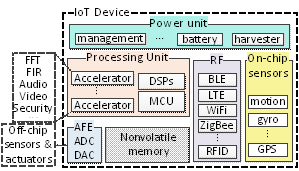With the rapid enhancements in embedded design, low-power wireless technologies, and sensors, we have witnessed an explosion in the number of smart devices. These devices, alongside the proliferation of smartphones have enabled the emerging paradigm of Internet-of-Things (IoT). In this paradigm, the smart devices that surround us are connected to each other and to the Internet in order to provide new and better functions. IoT covers a wide range of applications including smart home, smart building, smart city, smart industry, healthcare monitoring, etc.
For each application, an IoT system usually consists of several components and abstraction layers. From a network perspective, it consists of 1) IoT edge nodes or embedded IoT devices, 2) gateways, 3) cloud systems. An embedded IoT device consists of several components including (i) embedded processor, (ii) sensors or data acquisition, and (iii) wireless radio like Bluetooth.


Due to the wide range of IoT applications, the requirements and design objectives are diverse. From an embedded computing point of view, the main design objectives include: low-power, highly reliable, real-time or low-latency, small size, just to name a few.
In this seminar, our main focus is to study different challenges of IoT from embedded design and network level perspective. Topics include but are not limited to ultra-low power processors, low-power wireless radio, Approximate computing for IoT, edge computing, computation offloading, etc.
Language: English
Application: Registration form
Meeting Schedule: Will be informed vie email after registration